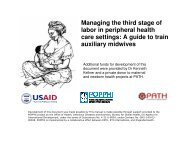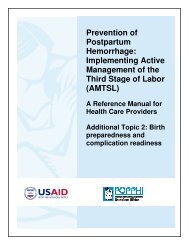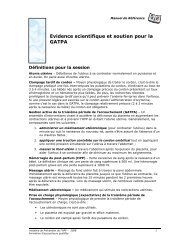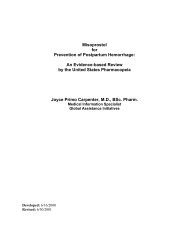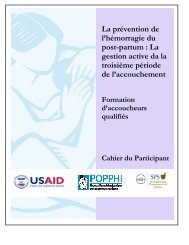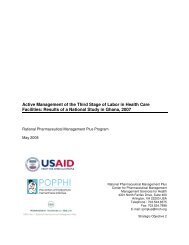El Salvador - Active Management of the Third Stage of Labor - POPPHI
El Salvador - Active Management of the Third Stage of Labor - POPPHI
El Salvador - Active Management of the Third Stage of Labor - POPPHI
Create successful ePaper yourself
Turn your PDF publications into a flip-book with our unique Google optimized e-Paper software.
1. BackgroundPostpartum hemorrhage is one <strong>of</strong> <strong>the</strong> world’s leading causes <strong>of</strong> maternal mortality. <strong>Active</strong>management <strong>of</strong> <strong>the</strong> third stage <strong>of</strong> labor (AMTSL) is a feasible and inexpensive intervention thatcan help save thousands <strong>of</strong> women’s lives.AMTSL involves three main components:• The use <strong>of</strong> a uterotonic agent within one minute following <strong>the</strong> birth <strong>of</strong> <strong>the</strong> baby.• Delivery <strong>of</strong> <strong>the</strong> placenta with controlled cord traction.• Massage <strong>of</strong> <strong>the</strong> uterus after delivery <strong>of</strong> <strong>the</strong> placenta.This definition is supported by <strong>the</strong> International Federation <strong>of</strong> Gynecology and Obstetrics(FIGO), <strong>the</strong> International Confederation <strong>of</strong> Midwives (ICM) 1 and <strong>the</strong> World Health Organization(WHO) 2 . This definition differs from <strong>the</strong> original research protocol in <strong>the</strong> Bristol 3 andHinchingbrooke 4 trials because <strong>the</strong> original protocols include immediate cord clamping and didnot include massage <strong>of</strong> <strong>the</strong> uterus. The FIGO/ICM joint statement 1 and Managing Complicationsin Pregnancy and Childbirth, 5 produced by WHO, do not include immediate cord clamping.Clinical trials in developed countries have shown that <strong>the</strong> use <strong>of</strong> AMTSL significantly reducespostpartum hemorrhage, in contrast to physiologic management <strong>of</strong> <strong>the</strong> third stage <strong>of</strong> labor whereoxytocic drugs are not used and <strong>the</strong> placenta separates spontaneously and is delivered by gravityand maternal effort. When compared to AMTSL, <strong>the</strong> use <strong>of</strong> physiologic management has ahigher rate <strong>of</strong> postpartum hemorrhage and severe postpartum hemorrhage, greater need for bloodtransfusion and <strong>the</strong>rapeutic oxytocics, and a longer duration <strong>of</strong> <strong>the</strong> third stage <strong>of</strong> labor. ACochrane review <strong>of</strong> <strong>the</strong>se trials concludes by recommending AMTSL for all women deliveringin a hospital and anticipating <strong>the</strong> vaginal birth <strong>of</strong> a single infant. 6Endorsement and use <strong>of</strong> AMTSLBased on this body <strong>of</strong> evidence, ICM and FIGO issued a joint statement in November 2003stating that every woman should be <strong>of</strong>fered AMTSL “as a means <strong>of</strong> reducing <strong>the</strong> incidence <strong>of</strong>postpartum hemorrhage due to uterine atony.” 1 The inclusion <strong>of</strong> AMTSL in <strong>the</strong> WHO evidencebasedmanual Managing Complications in Pregnancy and Childbirth also attests to <strong>the</strong>international acceptance <strong>of</strong> this practice as <strong>the</strong> standard <strong>of</strong> care. 5Evidence regarding adoption <strong>of</strong> this practice, however, is limited. Evaluations <strong>of</strong> donor-fundedprojects incorporating AMTSL tend to be limited to reporting on <strong>the</strong> numbers <strong>of</strong> providerstrained and <strong>the</strong> percent achieving competence following training. Apart from anecdotalinformation, a 2003 article by <strong>the</strong> Global Network for Perinatal and Reproductive Health (Festinet al.) 7 <strong>of</strong>fers a limited glimpse into <strong>the</strong> adoption <strong>of</strong> this practice. Their results, based on anevaluation <strong>of</strong> 15 university-based referral obstetric centers in developed and developingcountries, show substantial variation between and within hospitals. Overall, only 25 percent <strong>of</strong>observed deliveries included AMTSL. Only one (in Dublin, Ireland) consistently used all threecomponents <strong>of</strong> <strong>the</strong> practice. Variation in <strong>the</strong> prophylactic use <strong>of</strong> oxytocic drugs ranged from 0 to100 percent; <strong>the</strong> practice <strong>of</strong> controlled cord traction ranged from 13 to 100 percent; and <strong>the</strong>number <strong>of</strong> women who received additional doses <strong>of</strong> oxytocin during <strong>the</strong> third stage <strong>of</strong> labor4



